Super Submarines
Dark, cold and silent, the unexplored depths of our world’s oceans have long presented both a technical challenge for scientists and a fascinating test of the imagination for science fiction writers. Today we take a look at the some of the fiction of science-fictional submarines, and what it can tell us.
Super-Subs
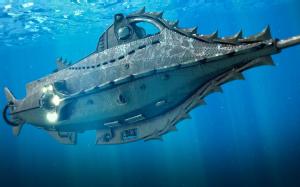 One of the most memorable and best-known early science fiction novels was Jules Verne’s Twenty Thousand Leagues Under the Sea (1872). This tells the story of a marine scientist, Professor Pierre Aronnax. who sets out to investigate a series of attacks on shipping, which he believes are due to a hitherto undiscovered form of ocean life. Instead, he is saved from drowning by Captain Nemo - the maverick genius whose incredible submarine the Nautilus is responsible for the shipping losses. Through the following undersea journey, he - and the reader - learn something of Nemo’s background and motivation, and about life in the ocean depths, as well as about the technologically-advanced Nautilus herself. Nemo, while ruthless, is also a gentleman scientist with a passion for his ocean world. At the time he was writing, Verne was aware of some early submarine prototypes as well as extrapolating other technologies, such as electrical power systems and underwater breathing apparatus. However he was not afraid to also add fantasy into the mix with the inclusion of an excursion to Atlantis on his vessel’s itinerary.
One of the most memorable and best-known early science fiction novels was Jules Verne’s Twenty Thousand Leagues Under the Sea (1872). This tells the story of a marine scientist, Professor Pierre Aronnax. who sets out to investigate a series of attacks on shipping, which he believes are due to a hitherto undiscovered form of ocean life. Instead, he is saved from drowning by Captain Nemo - the maverick genius whose incredible submarine the Nautilus is responsible for the shipping losses. Through the following undersea journey, he - and the reader - learn something of Nemo’s background and motivation, and about life in the ocean depths, as well as about the technologically-advanced Nautilus herself. Nemo, while ruthless, is also a gentleman scientist with a passion for his ocean world. At the time he was writing, Verne was aware of some early submarine prototypes as well as extrapolating other technologies, such as electrical power systems and underwater breathing apparatus. However he was not afraid to also add fantasy into the mix with the inclusion of an excursion to Atlantis on his vessel’s itinerary.
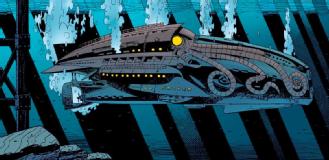 Captain Nemo and the Nautilus had sufficient fame to appear in a sequel (The Mysterious Island, 1875) and in a large number of film, television and radio adaptations. Of these the Disney film 20,000 Leagues Under the Sea (film 1954, dir. Fleischer) is also notable for hinting that the Nautilus was atomic powered, and indeed, despite its hostile background, the vessel was used as an illustration of potential peaceful uses of atomic power in Disney’s factual documentary television film Our Friend the Atom (1957). However a less peaceful Nemo, with a bitter and vindictive edge closer to the original text, can be found in the influential comic series The League of Extraordinary Gentlemen, written by Alan Moore and illustrated by Kevin O’Neill (comics 1999 onwards; film 2003, dir. Norrington). This steampunk premise mashes together a number of classic nineteenth and early twentieth century speculative fiction characters, gives them advanced technologies for their time, and places them in a collaboration, fighting against villains with equally advanced technologies. In this context, the Nautilus - as an icon of advanced technology as imagined in the nineteenth century - provides a natural base of operations for the members of the League. In common with most steampunk, The League of Extraordinary Gentlemen pushes the technology concerned to the limits of what might have been possible with Victorian materials, rather than remaining constrained by what was actually achieved.
Captain Nemo and the Nautilus had sufficient fame to appear in a sequel (The Mysterious Island, 1875) and in a large number of film, television and radio adaptations. Of these the Disney film 20,000 Leagues Under the Sea (film 1954, dir. Fleischer) is also notable for hinting that the Nautilus was atomic powered, and indeed, despite its hostile background, the vessel was used as an illustration of potential peaceful uses of atomic power in Disney’s factual documentary television film Our Friend the Atom (1957). However a less peaceful Nemo, with a bitter and vindictive edge closer to the original text, can be found in the influential comic series The League of Extraordinary Gentlemen, written by Alan Moore and illustrated by Kevin O’Neill (comics 1999 onwards; film 2003, dir. Norrington). This steampunk premise mashes together a number of classic nineteenth and early twentieth century speculative fiction characters, gives them advanced technologies for their time, and places them in a collaboration, fighting against villains with equally advanced technologies. In this context, the Nautilus - as an icon of advanced technology as imagined in the nineteenth century - provides a natural base of operations for the members of the League. In common with most steampunk, The League of Extraordinary Gentlemen pushes the technology concerned to the limits of what might have been possible with Victorian materials, rather than remaining constrained by what was actually achieved.
Moving forward in time from the nineteenth century, fictional boy genius inventor Tom Swift was also attracted by the unknowns of the ocean deeps, showing an early interest in the then-novel technology in Tom Swift and his Submarine Boat (1910) and developing this further in Tom Swift and his Undersea Search (1922). The long running series of children’s science-and-technology fiction returned to the subject of super-submarines in its second incarnation. Here the son of the the original Tom Swift took advantage of atomic power and a raft of hypothesised new materials, developing a number of underwater craft in novels such as Tom Swift and his Jetmarine (1954), …his diving seacopter (1956), … his deep sea hydrodome (1958), … his electronic hydrolung (1961), …his aquatomic tracker (1964), …his subocean geotron (1966) and … his dyna-4 capsule (1969). The last of these was a scientific research vessel specifically designed to survive high pressures and explore the deepest ocean trenches.
Another Atomic Submarine was the subject of a 1957 science fiction novel of that name by Alistair Mars. Subtitled “a story of tomorrow” this was written by a former World War II submarine commander with the Royal Navy. It was set in the near future and within the context of Cold War nuclear tensions [1], but highlighted the potential capacity of a submarine powered by atomic energy to endure long tours of duty fully submerged - as indeed was beginning to be the case in actual operations. Here we see not so much a super-sub but a potentially realisable vessel that (at the time) would have seemed a terrifyingly modern weapon. The same theme is picked up in Frederik Pohl's 1956 novel Slave Ship. This told of a near-future where global war was being fought between the Americas and a religious empire spreading from the Far East. In an effort to avoid all-out nuclear annihilation, both sides opt to engage primarily in submarine warfare, where most of the action is hidden and occurs well away from the continental mainlands. While the novel focuses on a project to engage animal intelligence in the conflict, the central character is a submariner drafted from a 40,000 ton displacement atomically-powered underwater cruiser and a number of others are referenced throughout.
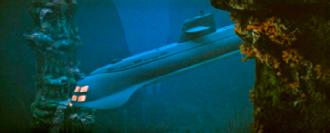 A different atomic sub features in the film Voyage to the Bottom of the Sea (1961, dir. Allen), which begins with a scene of the US experimental submarine Seaview breaching the surface like a whale, before a series of newspaper headlines inform us that the new atomic “super-sub” is on trials below the arctic. Unlike many super-subs, Seaview looks rather like a regular navy submarine in the film, albeit with large forward viewing windows. However, we’re soon told that “not even Jules Verne thought of anything like this”. Seaview is operated very much a military vessel, although its civilian ownership and scientific research remit is also stressed. While the vessel is submerged on a long exploration under the ice cap, the van Allen belt (layers in the upper atmosphere where the combination of Earth’s magnetic field and the Sun’s solar wind trap ionized particles and other radiation) catches fire for unknown reasons. The story follows a tense attempt to dampen the threat before the world burns to death.
A different atomic sub features in the film Voyage to the Bottom of the Sea (1961, dir. Allen), which begins with a scene of the US experimental submarine Seaview breaching the surface like a whale, before a series of newspaper headlines inform us that the new atomic “super-sub” is on trials below the arctic. Unlike many super-subs, Seaview looks rather like a regular navy submarine in the film, albeit with large forward viewing windows. However, we’re soon told that “not even Jules Verne thought of anything like this”. Seaview is operated very much a military vessel, although its civilian ownership and scientific research remit is also stressed. While the vessel is submerged on a long exploration under the ice cap, the van Allen belt (layers in the upper atmosphere where the combination of Earth’s magnetic field and the Sun’s solar wind trap ionized particles and other radiation) catches fire for unknown reasons. The story follows a tense attempt to dampen the threat before the world burns to death.
The film led to a long-running spin-off television series of the same name Voyage to the Bottom of the Sea (TV, 1964-8) which followed the submarine’s further adventures in a range of disaster, military, thriller and science fictional scenarios of varying degrees of plausibility. These included stories reflecting contemporary concerns regarding food supply, bio-engineering, mind-control, automation and cybernetics, as well as nuclear warfare, supernatural manifestations, a range of sea monsters, a few plant people and far, far more aliens and UFOs than any submarine should ever find itself facing. It even acted as an underwater launch platform for a space probe in one episode. As in the film, the Seaview is described as privately owned and operated by the Nelson Institute for Marine Research, but is staffed by ex-Navy personnel and operated according to Navy regulations... as is only appropriate for a nuclear-armed ICBM-carrying attack submarine. From the second season of the TV series, the Seaview also boasted a "Flying Sub" - an auxiliary craft itself resembling a flying saucer which could both fly as a jet aeroplane and dive as a submarine.
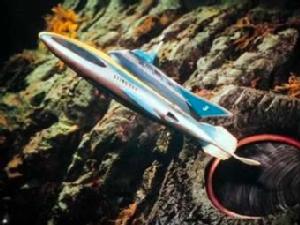 In the same tradition of cutting-edge, super-technology submarines we find the supermarionation children’s science fiction television series Stingray (TV, AP films for ITC entertainment, 1964-5). This series follows the adventures of the titular craft and its crew - led by Captain Troy Tempest of the World Aquanaut Security Patrol (WASP). Throughout the series and its associated spin-off media, Stingray is described as a super-sub, with speed and depth capabilities far in excess of most other craft, including her sister craft in WASP and the “terror fish” submarines controlled by a race of subaquatic non-humans known as aquaphibians, under the control of their king Titan. As in many other submarine stories, there is a mixture of fantasy (mermaids, Atlantis etc) into the science fictional elements of the series. However the series is notable for imagining a number of different, related but distinct, sentient underwater civilisations, peopled by species ranging from the monstrous to the near-human. In many ways, Stingray was simply an underwater transposition of the earlier space-exploration series Fireball XL5, made by the same creatives, and shows a similar disregard to the ethical implications of exploiting indigenous peoples, their environments or resources. It does nonetheless highlight some of those issues - recognising the source of conflict in some episodes as being due to actions of human surface-dwellers, while blithely ignoring the question of culpability in others. Stingray’s technology is never really explored in the series, although some detail is provided in the series' supporting media such as comics and reference books. The series' effective recognition of the unknown and potential dangers of undersea human activity makes for compelling storylines at times.
In the same tradition of cutting-edge, super-technology submarines we find the supermarionation children’s science fiction television series Stingray (TV, AP films for ITC entertainment, 1964-5). This series follows the adventures of the titular craft and its crew - led by Captain Troy Tempest of the World Aquanaut Security Patrol (WASP). Throughout the series and its associated spin-off media, Stingray is described as a super-sub, with speed and depth capabilities far in excess of most other craft, including her sister craft in WASP and the “terror fish” submarines controlled by a race of subaquatic non-humans known as aquaphibians, under the control of their king Titan. As in many other submarine stories, there is a mixture of fantasy (mermaids, Atlantis etc) into the science fictional elements of the series. However the series is notable for imagining a number of different, related but distinct, sentient underwater civilisations, peopled by species ranging from the monstrous to the near-human. In many ways, Stingray was simply an underwater transposition of the earlier space-exploration series Fireball XL5, made by the same creatives, and shows a similar disregard to the ethical implications of exploiting indigenous peoples, their environments or resources. It does nonetheless highlight some of those issues - recognising the source of conflict in some episodes as being due to actions of human surface-dwellers, while blithely ignoring the question of culpability in others. Stingray’s technology is never really explored in the series, although some detail is provided in the series' supporting media such as comics and reference books. The series' effective recognition of the unknown and potential dangers of undersea human activity makes for compelling storylines at times.
Underwater Claustrophobia
One of the deepest fears of the crew of any submarine - super or otherwise - must be the risk of disaster underwater. In an environment just as unforgiving as deep space, and in vessels which are typically shown as compact and with a finite air supply, writers find a compelling and claustrophobic setting.
This can be seen for example in television SF-fantasy-SpyFi series The Champions (TV, ITC Entertainment, 1968-9). Several episodes involve the then-novel nuclear submarine fleet and the potential threat they pose if misused or mislaid. While the episode “Twelve Hours” has few science fictional elements, the tension is skillfully built up as the characters battle to survive trapped deep underwater in a crippled sub, with important plot points depending on the technology of the British military submarine in question and of underwater communications.
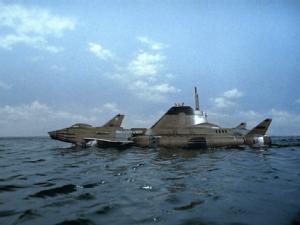 Another, and more overtly SF, example can be found in another television series, UFO (TV, ITC Entertainment, 1970-1). The super-sub here is SkyDiver, a powerful and fast submarine coupled to a jet interceptor aircraft (Sky-1) that is capable of launching from underwater (much like Voyage to the Bottom of the Sea's Flying Sub). The submarine’s nominal submerged steady speed of 40 knots matches current underwater speed records. In the series, SkyDiver is just one element in the defences of the anti-alien, quasi-military taskforce SHADO. However it comes to particular prominence in the episode “Sub Smash”. Here Commander Straker of SHADO is trapped aboard when the ship is crippled by a submarine-capable UFO, and has to fight both his own claustrophobia and the understandable panic of the ship’s crew to ensure their safe escape.
Another, and more overtly SF, example can be found in another television series, UFO (TV, ITC Entertainment, 1970-1). The super-sub here is SkyDiver, a powerful and fast submarine coupled to a jet interceptor aircraft (Sky-1) that is capable of launching from underwater (much like Voyage to the Bottom of the Sea's Flying Sub). The submarine’s nominal submerged steady speed of 40 knots matches current underwater speed records. In the series, SkyDiver is just one element in the defences of the anti-alien, quasi-military taskforce SHADO. However it comes to particular prominence in the episode “Sub Smash”. Here Commander Straker of SHADO is trapped aboard when the ship is crippled by a submarine-capable UFO, and has to fight both his own claustrophobia and the understandable panic of the ship’s crew to ensure their safe escape.
A different, but equally claustrophobic use of a submarine as an enclosed environment containing danger can be found in the Doctor Who episode “Cold War” (2013). In this narrative, the crew of a soviet nuclear submarine of the 1980s must combat not only their own political biases but also the threat of an Ice Warrior (in fact, a displaced native of the planet Mars) who is found in the polar ice, and (somewhat unwisely) brought aboard and allowed to defrost. The tight passageways of the craft, the limited pool of both people and space in which to escape and the constant threat of the environment heighten the tension throughout.
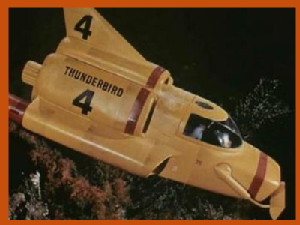 Of course, many of the characters trapped in these submarines might benefit from the existence of a specialised undersea rescue craft. It would be negligent to talk about super-submarines and undersea disaster in science fiction without mentioning Thunderbird Four. The television series Thunderbirds (1965, from the same creative team as Stingray and UFO) featured five primary rescue craft, each designed to mitigate disasters in a different range of environments. Amongst them, Thunderbird Four is the smallest - a yellow rescue submarine with special responsibility for underwater rescues. Its outings during the series are somewhat limited, with quite a lot of debris clearing and casualty-location work. By contrast International Rescue saw more submarine rescue action in the early anime adaptation Thunderbirds 2086 (a.k.a. Kagaku Kyūjo Tai Tekunoboijā, TV 1982), and again in the 2015 Thunderbirds Are Go animated reimagining of the series, including a rather unlikely submarine rescue in the oceans of Jupiter’s moon Europa (“Deep Search”, 2016). As with other super-subs mentioned here, Thunderbird Four is described as having capacities for speed and depth tolerance in excess of normal underwater vessels, as well as robotic arms for manipulation, cutting torches and debris clearing missiles. Thunderbird Four, while frequently having to deal with technical mishaps, as well as human ignorance and negligence, at least escapes its cousin Stingray’s constant struggle against the denizens of the deep.
Of course, many of the characters trapped in these submarines might benefit from the existence of a specialised undersea rescue craft. It would be negligent to talk about super-submarines and undersea disaster in science fiction without mentioning Thunderbird Four. The television series Thunderbirds (1965, from the same creative team as Stingray and UFO) featured five primary rescue craft, each designed to mitigate disasters in a different range of environments. Amongst them, Thunderbird Four is the smallest - a yellow rescue submarine with special responsibility for underwater rescues. Its outings during the series are somewhat limited, with quite a lot of debris clearing and casualty-location work. By contrast International Rescue saw more submarine rescue action in the early anime adaptation Thunderbirds 2086 (a.k.a. Kagaku Kyūjo Tai Tekunoboijā, TV 1982), and again in the 2015 Thunderbirds Are Go animated reimagining of the series, including a rather unlikely submarine rescue in the oceans of Jupiter’s moon Europa (“Deep Search”, 2016). As with other super-subs mentioned here, Thunderbird Four is described as having capacities for speed and depth tolerance in excess of normal underwater vessels, as well as robotic arms for manipulation, cutting torches and debris clearing missiles. Thunderbird Four, while frequently having to deal with technical mishaps, as well as human ignorance and negligence, at least escapes its cousin Stingray’s constant struggle against the denizens of the deep.
The People Under the Sea
The battle of submarines with giant squids or other monsters of the deep is so routine in fiction, it is effectively a cliché. But it’s not only animals who present a threat. The idea that the deliberate action of sentient races - civilised rivals to humanity - might be amongst the dangers of the deep [2] has a long history, which arguably goes back to the sea gods of ancient legend, and merged over time with the legends of Atlantis. It emerged into science fiction in the H G Wells short story “In the Abyss” (1896, text). In this story, the occupants of the first diving bell to descend into the deep ocean trenches look through their porthole and witness the existence of an entire city and population that was unaware of humanity’s existence as humanity had been of theirs.
Alongside Stingray’s aquaphibians, and amongst other fictions to people the depths with sentient humanoids, we find another aquatic race in the television series Doctor Who. The mythology of this long-running series includes the premise that Earth was once ruled by a sentient saurian race known as the SIlurians, who went into suspended animation long before the dinosaurs became extinct, and were never revived. In the serials “The Sea Devils” (1972) and “Warriors from the Deep” (1984) we discover that a second, related species, the titular sea devils, occupied a submarine evolutionary niche and formed part of the same overarching culture. While we see relatively little of the Sea Devils’ own culture in these serials, or in the special episode “Legend of the Sea Devils” (2022), it is expanded upon in a number of the Doctor Who spin off novels and audio adventures, notably Scales of Justice (novel, Russell 1996), which focuses on a shunned and displaced colony of Silurian-Sea Devil hybrids.
Living Under the Sea.
Besides aliens (both Earth-born and extraterrestrial) living under the sea, science fiction has also explored a perhaps more plausible and exciting species of potential undersea residents - humanity themselves. Some time ago, I looked at fictions in which humanity had adapted itself genetically or technologically to unsupported undersea life. However a range of science fictions also explore human underwater settlements where conventional, oxygen-breathing humans are reliant on submarine vessels and pressurised colonies [3].
Verne’s 20,000 Leagues Under the Sea had argued that everything humans required to survive in the long term could be found underwater, but his Nautilus still needed to surface for air and had presumably been constructed on the surface. Later science fiction suggested that even this might not be necessary. In the mid-twentieth century, as overpopulation, resource depletion and starvation threatened to devastate the Earth’s surface, the idea of farming the oceans became popular in mainstream culture and scientific research as well as fiction. In particular, algae was seen as a potential staple crop, while free-range farming of fish and aquatic mammals was predicted to supplement the food supply. This future is explored in science fictional examples such as Arthur C Clarke’s novel The Deep Range (1957, which featured a range of submarine craft including those designed for routine farming, transport craft, and others for hunting sharks or killer whales.
An earlier stage in the process of establishing such underwater settlements can be seen in Isaac Asimov’s short story “Waterclap” (Worlds of If, 1970). Here the first experimental underwater settlement and the first moon colony are positioned as in opposition and competition for the same limited research and exploration funding streams, explicitly placing the science fiction of underwater exploration in the context of space exploration. The waterclap referred to in the title, by the way, is the sound of an underwater vessel being forced against a settlement airlock by water pressure when docking.
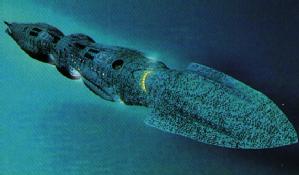 A much more developed system of underwater settlement, by contrast, can be found in the television series seaQuest DSV (TV, 1993-6). The titular “deep submergence vessel” is the flagship of the United Earth Oceans Organisation (UEO) - a United Nations-like authority responsible for both supporting and policing the newly burgeoning underwater community. This comprises everything from agricultural and civilian settlements to military and research compounds. The crew likewise mixed navy officers with civilian personnel, including dolphins who were used for scouting and could communicate with the crew. The vessel herself shares the familiar tropes of super-submarines including both speed and capacity to resist the pressure in the ocean depths. However the situations she encounters across three seasons of episodes are more complex than those seen in many of the other fictions mentioned here, varying between pure scientific exploration, military exercises (although seaQuest herself is a civilian craft, as her forerunner Seaview was in the similar series Voyage to the Bottom of the Sea), dealing with resource conflicts, environmental issues, handling terrorist threats and simple supply runs, much like Star Trek’s more famous starship Enterprise, but in a dark space entirely contained within Earth’s oceans [4]. Unfortunately, the production of the series appears to have been rather fraught and it fared poorly in the ratings against contemporary competitor science fiction series.
A much more developed system of underwater settlement, by contrast, can be found in the television series seaQuest DSV (TV, 1993-6). The titular “deep submergence vessel” is the flagship of the United Earth Oceans Organisation (UEO) - a United Nations-like authority responsible for both supporting and policing the newly burgeoning underwater community. This comprises everything from agricultural and civilian settlements to military and research compounds. The crew likewise mixed navy officers with civilian personnel, including dolphins who were used for scouting and could communicate with the crew. The vessel herself shares the familiar tropes of super-submarines including both speed and capacity to resist the pressure in the ocean depths. However the situations she encounters across three seasons of episodes are more complex than those seen in many of the other fictions mentioned here, varying between pure scientific exploration, military exercises (although seaQuest herself is a civilian craft, as her forerunner Seaview was in the similar series Voyage to the Bottom of the Sea), dealing with resource conflicts, environmental issues, handling terrorist threats and simple supply runs, much like Star Trek’s more famous starship Enterprise, but in a dark space entirely contained within Earth’s oceans [4]. Unfortunately, the production of the series appears to have been rather fraught and it fared poorly in the ratings against contemporary competitor science fiction series.
The challenge of the deeps
Perhaps it is unsurprising that the parallel technical innovations taking humanity into space and into the deep oceans in the 1950s and early 60s raised the profile of submarines amongst science fiction creators. The themes of a venue for new opportunities, potential new resources to relieve the pressure on Earth’s surface, and exploration of the unknown, applied as well to the ocean depths as those of space, and super-submarines were based on a technology that was better understood than rocket travel at the time. Indeed examples such as Asimov’s "Waterclap" and Clarke’s The Deep Range explicitly drew parallels between space and deep sea exploration.
However this relatively accessible near-contemporary technology perhaps dulled some of the edge of excitement of submarines in science fiction. The technical innovations that render a near-future submarine science fictional rather than just contemporary fiction might be seen as minor or incremental, rather than revolutionary. Indeed the common properties that elevate science fictional super-subs above normal submarines are simply matters of scale - they can travel faster, deeper and for longer - but it might not be clear to many audiences why normal submarines are not capable of these feats or how they push beyond the current bounds of technology. In terms of submerged time, indeed, modern submarines have almost certainly caught up with their science fictional super-sub counterparts. Speed is a harder problem to surmount - compared to travelling through air (let alone vacuum!), a submarine is effectively wading through treacle. The power input to move through a fluid scales in proportion to the drag force, which in turn depends on the square of the velocity. So tripling the speed of an underwater craft implies increasing its power requirement by around a factor of ten.
Not only does it require more power to overcome the constant drag force of water, it will also experience significant friction against its surface, with associated heating of the submarine interior and the turbines or other motor systems. As a result the underwater speed record for human-occupied submarines is only in the range 40-45 knots for short bursts - less than a hundred miles an hour - with substantially slower cruising speeds (subject to some uncertainty given the classified nature of military capabilities). By contrast, the cruising speed of Captain Nemo’s Nautilus was 43 knots, Thunderbird Four and Seaquest DSV could each make 160 knots, while the nominal submerged speed of Stingray was a staggering 600 knots! These fast vessels must not only be highly streamlined but also typically boast novel materials on their surfaces. In the case of seaQuest DSV this is a genetically engineered bio-skin, while craft such as Thunderbird Four are described as having a secret advanced anti-friction coating. They are also typically atomically (ideally fusion) powered, in order to drive their futuristic propulsion.
Comparable in difficulty is the issue of depth. As the tragic implosion of the Titan submersible earlier in 2023 demonstrated, submarines must provide resistance against enough pressure to press them flat. This problem was succinctly described by Wells in "In The Abyss":
“But think of the pressure,” said the lieutenant. “At the surface of the water it’s fourteen pounds to the inch, thirty feet down it’s double that; sixty, treble; ninety, four times; nine hundred, forty times; five thousand, three hundred—that’s a mile—it’s two hundred and forty times fourteen pounds; that’s—let’s see—thirty hundredweight—a ton and a half, Steevens; a ton and a half to the square inch. And the ocean where he’s going is five miles deep. That’s seven and a half”—
“Sounds a lot,” said Steevens, “but it’s jolly thick steel.”
While thick steel might have sufficed for a simple bathysphere (spherical diving bell) such as Wells’ explorer used, submarines must balance their structural strength with capacity, speed, power and other concerns. Cylindrical structures are intrinsically less robust than spherical ones. This keeps the floor for most conventional submarines to relatively shallow depths. Most navy submarines operate at less than a kilometre in depth, and most cannot dive significantly deeper than this without risking implosion. Deep sea research submersibles capable of diving to the ocean bed instead tend to be tiny, near-spherical craft, kept small so as to provide the most rigid possible structure. By contrast, science fictional submarines are typically shown as huge vessels able to probe the deepest ocean trenches on Earth (which reach 11 kilometres). Indeed a key incident in the film Voyage to the Bottom of the Sea hinges on Seaview’s capacity to take a greater depth than the conventional submarines hunting it, although the series continuity is rather lax and a surprising variety of crush depths and speeds are reported in the course of the series. SeaQuest DSV reaches about 6.5 kilometres in its pilot episode, while Stingray is shown as capable of reaching depths of several miles below the floor of the Atlantic Ocean (e.g. in the episode “Deep Heat” where the sub descends the shaft of a sub-aquatic volcano, or in “Treasures of the Deep” where she is sucked downwards in an underwater vortex).
For the super-subs to operate as seen requires technology well beyond our current capabilities - particularly in the area of materials science and construction technology. The same applies, of course, to most science fictional underwater habitats, although these at least can be constructed for static and stable pressures rather than changes in depth or rapid motion. However the rate of development of new materials continues to accelerate. While the ill-fated Titan submersible ultimately proved flawed, new material science drove its design, and will continue to allow innovation in submarines of the future. And such innovation is highly likely to find investors and enthusiasm. Despite a decline since the peak of enthusiasm for the technologically-thrilling nuclear subs in the 1950s and 60s, the same sense of adventure, exploration and excitement that continues to drive humanity to explore space is also manifest in a continued interest in exploring the unknown regions of the Earth's ocean.
The materials required to reproduce science fiction’s super-subs may fall into the category of unobtanium. We may never reach the remarkable specifications of super-subs such as Stingray. The continued interest and development in our probing of the ocean depths will nonetheless continue to drive forward the sense of exploration and mystery fundamental to the genre and its relationship with oceanic science.
“Super Submarines”, Elizabeth Stanway. Cosmic Stories blog. 5th November 2023.
Notes:
[1] I’m not going to delve any further into cold war thriller territory here, but it’s worth noting that examples of atomically powered or armed submarines abound in then-near-future, now long since dated, spy and political dramas through the mid-twentieth century. These ranged from novels to television and film dramas, with other interesting SF-oriented examples including Frank Herbert’s The Dragon in the Sea (novel, 1956). [Return to text]
[2] Of course, while the peoples of the deep in SF are aliens in the sense of being non-human intelligences, the science fiction of submarines also touches on true extraterrestrials who happen to have taken up residence below the waves. Examples include Wyndham’s The Kraken Wakes (1953) and the film The Abyss (1989) amongst others - although in the interests of brevity I’m not going to discuss these further here. I’m also going to skip rapidly past the science fiction of submarines on other planets - both are topics I might return to in future. [Return to text]
[3] There's a lot more to be said on the topic of underwater human settlement and I may come back to this as well - again, to keep this already-long blog entry under control, I'm going to stay focussed here on the subs themselves. [Return to text]
[4] Except that time seaQuest DSV was kidnapped by aliens… let’s not mention that. Oh... or the time Seaview was too. Or the times Thunderbird Four was sent into space. [Return to text]
The views and opinions in this blog are those of the author and do not necessarily represent those of the University of Warwick. All images have been sourced online from publicly visible websites and are used here for commentary and review purposes.
